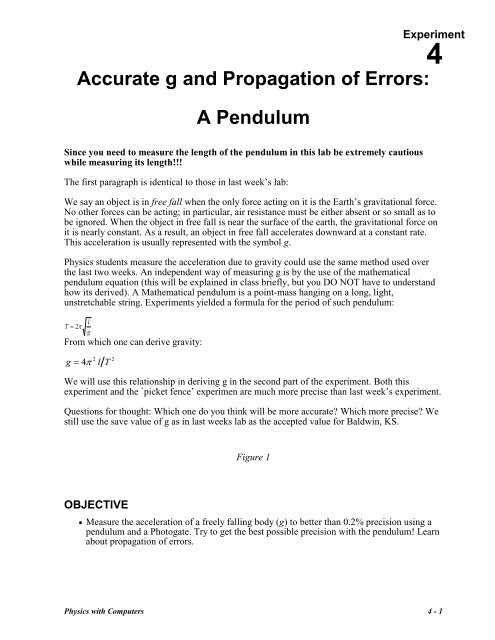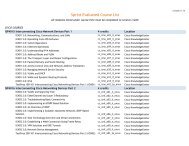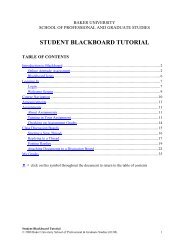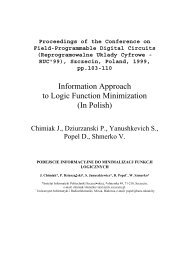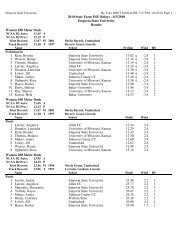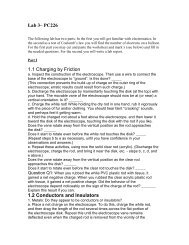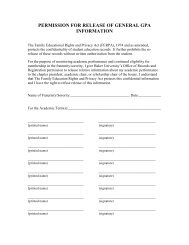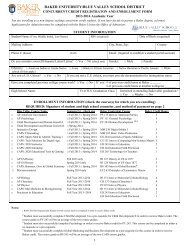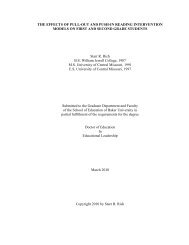Lab 3
Lab 3
Lab 3
- No tags were found...
Create successful ePaper yourself
Turn your PDF publications into a flip-book with our unique Google optimized e-Paper software.
Accurate g and Propagation of Errors:A PendulumExperiment4Since you need to measure the length of the pendulum in this lab be extremely cautiouswhile measuring its length!!!The first paragraph is identical to those in last week’s lab:We say an object is in free fall when the only force acting on it is the Earth’s gravitational force.No other forces can be acting; in particular, air resistance must be either absent or so small as tobe ignored. When the object in free fall is near the surface of the earth, the gravitational force onit is nearly constant. As a result, an object in free fall accelerates downward at a constant rate.This acceleration is usually represented with the symbol g.Physics students measure the acceleration due to gravity could use the same method used overthe last two weeks. An independent way of measuring g is by the use of the mathematicalpendulum equation (this will be explained in class briefly, but you DO NOT have to understandhow its derived). A Mathematical pendulum is a point-mass hanging on a long, light,unstretchable string. Experiments yielded a formula for the period of such pendulum:T 2lgFrom which one can derive gravity:g 2 24l TWe will use this relationship in deriving g in the second part of the experiment. Both thisexperiment and the `picket fence’ experimen are much more precise than last week’s experiment.Questions for thought: Which one do you think will be more accurate? Which more precise? Westill use the save value of g as in last weeks lab as the accepted value for Baldwin, KS.Figure 1OBJECTIVE Measure the acceleration of a freely falling body (g) to better than 0.2% precision using apendulum and a Photogate. Try to get the best possible precision with the pendulum! Learnabout propagation of errors.Physics with Computers 4 - 1
Experiment 4MATERIALSComputerVernier computer interfaceLogger ProVernier Photogateclamp or ring stand to secure PhotogatePRELIMINARY QUESTIONS1. Considering our theme of calibration from, what are you calibrating here?PROCEDURE1. Perform calibration. If you are not sure what that means, ask your instructor.2. Fasten the Photogate rigidly to a ring stand3. Connect the Photogate to the DIG/SONIC 1 input of the Vernier computer interface.4. Find g gfor a pendulum. Our pendulum will be made of a string and a hangingweight.You will measure the period of the pendulum using the photogate. StartLoggerPro, but do not use any of the software under “Vernier Physics”. se the photogateas a “stop watch”. Make sure you are measuring one full period. Once you are confidentthat you are measuring one full period call the instructor. It is highly recommended thatfor sake of precision you measure 10 full periods and divide the total time interval by 10.Repeat this measurement at least 5 times so that you can eventually get g g.Make sure not to hit the photogate in the process of measuring. Take note of the followingthat can influence your measurement directly or indirectly: Length of the wire, total lengthfrom pivot point to the center of mass of the weight, amplitude of oscillations (should be verysmall) and the number of oscillations. Each of those has some effect on the precision and/oraccuracy of the measurement of g.Use the equation on page 1 to obtain g for each period.About half way through the lab the instructor will explain the difference betweengobtained by standard deviation methods, and gobtained from error propagation. Errorpropagation is described in “Significant Figures and Error Analysis” below.Notes on propagation of errorsOften you have to compute a value of some physical quantity from measurement of twoor more physical quantities. You probably learned the rules of the number of significant figuresthat need to be kept in certain mathematical operations. Two questions that you may have askedyourself are: 1. Why does it work? 2. Is it accurate? This section will try to answer thesequestions. In the process you will find a method more accurate than the significant error method --- a method that works well with computers.4 - 2 Physics with Computers
PendulumI will use a simple example: the gravitational field, g, at the surface of the earth can becomputed from the measurement of the length L and the period T of a small amplitude pendulum(a swing), using the theoretically derived formula24Lg g(L,T)2TThe measurements of both L and T, however, are subject to experimental errors. Theseerrors are usually referred to as uncertainties. We want to know the uncertainty in our computedvalue of g, given the errors in L and T.These uncertainties could be due to the finite size of the smallest scale division (on themeter stick, or clock). They can also be due to a scatter in multiple readings (say you measuredT=1.97 seconds then 2.13 then 1.91 for the pendulum period).The uncertainty in g due to the error in L, which we call g L , can be computed bycalculating g twice. If, for example, L=0.96 0.01 m and the period is T=1.97 0.11 secondsthen224(0.97) 4(0.96)2g L g( L L,T) 0.10m/ s22(1.97) (1.97)Notice that we are NOT changing T here. We are only changing L by L.Similarly, the uncertainty in g due to the error in L, g T , is:g T224(0.96) 4(0.96) g( L,T T) 1.005m/ s22(2.08) (1.97)2Combining the uncertainties from both we get: g g2L g2T 1.009m/ s2It is customary to keep two significant figures in the error (at most). So we finally get: g 1.0m/ s2Using L=0.96m and T=1.97s we get g=9.76315. But this number does not make any sense! Thelast decimal in an experimental result should always be the last decimal in the error.So our result for g here is:g g 9.81.0m/ s2The percent error is:Physics with Computers 4- 3
Experiment 4gg1.005 0.10255 _ or _10.26%9.8We should note here that a large number of significant figures IN THE RESULT, NOT THEERROR, are always the marksmanship of a professional! If you are able to find g to 4 significantfigures as a mining engineer, for example, you can find the location of ore deposits that change glocally!Errors in Physics and Chemistry: Comparison with the "Usual" Sig.Fig. Method(This part can be skipped for the first 3 labs)I. Multiplication and division:For an equation:WH1) Z L(where Z, W,H, L are arbitrary quantities), The percent error in Z is:| Z| | W| | H| | L|2)100 100 100 100Z W H LWhere Z, W, H and L are the errors in Z, W, H and L respectively. The sign |X| means theabsolute magnitude of the quantity X.Example 1: Given W=9.99 0.11[kg], H=11.11111 0.00001[m/s] and L=5.55555 0.00001[s]we get, using the propagation of errors method:3) Z=19.8 0.2 [kg m/ s 2 ].The same example with the rules of sig. figs. in chemistry for W,H and L yields:4) Z=19.8 [kg m/s 2 ],where an error of 0.1 [kg m/s 2 ] is implicit.Example 2: Let W=9.9 0.1[kg], H=99 1[m/s], L=5.1 0.1[s]. Using the propagation of errorsmethod we get:5) Z=192.2 7.7[kg m/s 2 ].The same example, using sig.fig. rules in chemistry yields:6) Z=190[kg m/s 2 ]with an implicit error of 10[kg m/s 2 ].Note that in example 1 the error for the sig.fig. is smaller whereas in example 2 the error in thepropagation of errors method is smaller. The propagation of errors method is always moreaccurate, but may involve more calculations.Propagation of error in physics in the case of trigonometric function and powers:4 - 4 Physics with Computers
PendulumFor an equation:27) Z W Hthe percent error in Z isZWH8)100 2 100 1 100Z W 2 HThe factor 2 in front of the change in W can be explained as a result of the multiplication by Wtwice (squaring W). The factor 1/2 in front of H can only be derived by the use of calculus. Ifyou use sig.fig. rules in formulas similar to 7), you may be in trouble...Example:With W= 11.1 0.6,H=99.99 0.01 Z=1200 100, not Z=1230,which implies 10More complicated functions have other possible errors. For example:For an equationW9) Z = e cos ,the percent error in Z isZ10)100 100 W100Z and the last term has no ratio in it!III. Notes:1. The ratios |W|/W etc. have no units! These ratios are usually referred to asabsolute relative error.2. When an identical experiment is performed N times the average absolute deviation is theaverage of the-deviations-from-the-average: | W|=| ( i )/ N | . The average absolutedeviation is taken to be the error in the experiment, unless there is only one measurement or ifthere is zero deviation.Physics with Computers 4- 5
Experiment 44 - 6 Physics with Computers


